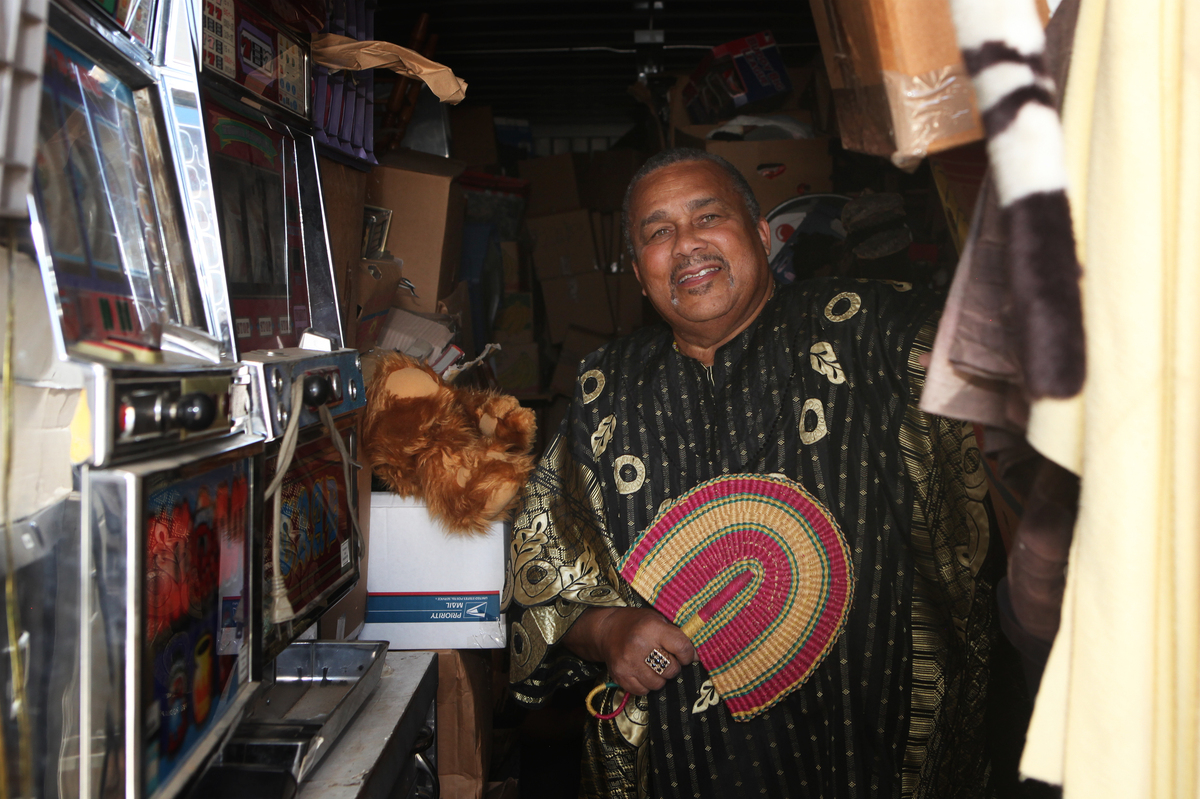 magnify this picture
magnify this picture Oran Z. Belgrave, founding father of the now defunct Oran Z's Black statistics & Wax Museum in los angeles, stands in entrance of the transport containers which have held lots of the contents of his unbiased African-American background museum in view that it closed in 2011. Samir S. Patel/Atlas Obscura disguise caption
toggle caption Samir S. Patel/Atlas Obscura
Oran Z. Belgrave, founder of the now defunct Oran Z's Black statistics & Wax Museum in los angeles, stands in entrance of the shipping containers that have held lots of the contents of his independent African-American history museum considering the fact that it closed in 2011.
Samir S. Patel/Atlas ObscuraSummertime is for highway trips. Atlas Obscura teamed up with All things considered to trip up the West Coast, from California to Washington, looking for "hidden wonders" — interesting but neglected people and places.
in the western tip of the Mojave wasteland, a few hours north of los angeles, a lone McMansion-trend villa sits on 10 acres surrounded via a fence. there is little however filth, photo voltaic farms and transmission towers for miles around.
On a contemporary afternoon, from the villa's oversize front door emerges a brief, heavyset black man donning an complicated black-and-gold agbada, a sleeved robe from West Africa. His identify is Oran Z.
before he moved to this remoted spot in 2012, he presided over an impartial museum of his own making, Oran Z's Pan-African Black information & Wax Museum in los angeles. It offered a dizzying kaleidoscope of black Americana, from wax figures to old artifacts to racist, Jim Crow-era memorabilia.
"We bought to retain the complete story," he says. "you've acquired to deal with it and in case you can not see it, it do not exist."

The lounge of Oran's residence in the Mojave wilderness is packed with objects from his museum, which latitude from Little Black Sambo collectible figurines to modern toys featuring black characters to art work through black artists. "We got to retain the total story," he says. Samir S. Patel/Atlas Obscura hide caption
toggle caption Samir S. Patel/Atlas ObscuraFrom 1999 to 2011, the regular local attraction offered an up shut and idiosyncratic view of African-American heritage in a largely black regional.
but when a enormous redevelopment undertaking got here to the enviornment, Oran says, he was forced to shut. He packed his assortment — some 3 million objects, he says — into shipping containers and exiled himself to the barren region.
Now, the passion project that he noticed as a public service has turn into a millstone.
Oran, 67, is battling each bad health and agonize over the way forward for his lifestyles's work — a strange, amazing chronicle of black Americana. there may be no one — or institution — lined as much as do something about the sprawling assortment, and he fears this slice of an often undocumented a part of African-American history can also die with him.
elements of this history are at present housed on the entire-to-bursting shelves that line most of the partitions within the front room of Oran and his spouse of 18 years, Betty Belgrave.
among them are some gadgets of ancient interest: baseballs from the Negro Leagues, slave shackles, a pink triangle badge used to mark Jehovah's Witnesses in Nazi concentration camps.
And there are many blatantly racist gadgets — from "Alligator Bait" postcards featuring black children and mammy-form cookie jars to forged-iron "Jolly N*****" coin banks.

Oran's assortment incorporates many objects that illustrate poor stereotypes, from shirtless, dark-skinned little ones on containers of Gold dirt Washing Powder (left) to cookie jars depicting the mammy housemaid caricature (correct). Samir S. Patel/Atlas Obscura conceal caption
toggle caption Samir S. Patel/Atlas ObscuraDerogatory depictions of African-american citizens have all the time interested Oran. they're disregarded items of black historical past, he says, now not often presented in museums. part of his mission, he says, is to keep them and make sure they are seen, as a method of realizing how black people have been dehumanized, objectified and belittled all over historical past.
Oran Z's story starts in Omaha, Neb., where he become born John Walter McLain III in 1951. At age 5, he became Oran Douglas Belgrave when his mother remarried; and later he adopted the identify Oran Z (impressed by Malcolm X).
He was raised a Jehovah's Witness and became a drummer and artist. As a younger man in the early Seventies, he found notion in Madam C.J. Walker, an entrepreneur and activist who made her fortune with African-American hair care items within the early 20th century. If she had been capable of prosper and make her mark on the area serving the black group, he figured, he could, too. So he went to elegance school.
After Oran married and had a daughter, he began purchasing and promoting antiques and collectibles to make extra money. He had a collecting computer virus from a younger age, and it grew into an activity in black historical past, exceptionally the stories of lesser-standard innovators and inventors like Walker.
right through this period, he encountered a buyer, a black woman and history trainer, who became in particular interested in racist memorabilia, gadgets that he discovered perplexing and entrancing.
 magnify this photo
magnify this photo Autographed baseballs from the Negro Leagues. Oran's museum finally sprawled out of its sixteen,000-rectangular-foot area in l. a. and into a couple of forty-foot shipping containers within the automobile parking space. Samir S. Patel/Atlas Obscura conceal caption
toggle caption Samir S. Patel/Atlas Obscura
Autographed baseballs from the Negro Leagues. Oran's museum at last sprawled out of its 16,000-square-foot space in l. a. and into several forty-foot transport containers in the automobile parking space.
Samir S. Patel/Atlas Obscura"sometimes i might study stuff and it would make me snicker and sometimes it would make me cry," he remembers.
Oran opened a salon in Omaha, then an antique shop and gallery, which came to center of attention solely on African-American objects. He called it the Black Americana Museum.
"I began amassing anything else and every thing for blacks, against blacks, about blacks, through blacks," he says. "If an African-American was represented, or if an African changed into represented, i wanted it."
Oran's collecting really took off within the early Nineteen Eighties, when he developed a line of hair-weave adhesives referred to as Oran's wonder Weave.
He traveled the country for hair alternate suggests, and, with this new salary, purchased every little thing he could find, from vintage shops, yard revenue and other collectors. He declines to say how plenty he spent through the years.
"I just thought that i was going to ultimate for roughly six months, so when I received my money i'd purchase black memorabilia," he says. "I have spent my last dime on things more than once."
 Race A Museum Teaches Tolerance via Jim Crow
Race A Museum Teaches Tolerance via Jim Crow Then came a painful and surprising divorce. seeking a fresh birth, Oran decamped to los angeles in the mid-Nineteen Nineties, leaving at the back of his company and most of his assortment at the time.
Oran lived in a rented office in Santa Barbara Plaza — a strip mall filled with black-owned companies in the 1st Earl Baldwin of Bewdley Hills-Crenshaw enviornment, about 6 miles southwest of downtown. There, he rebuilt each his hair care career and his museum: Oran Z's Pan-African Black information & Wax Museum.
Like many unbiased museums that develop out of personal collections, it wasn't curated, or full of explanatory panels. even though he at all times had an tutorial mission, Oran says he desired guests to event the objects — the decent, the bad and the ugly — without delay and form their own opinions.

Oran's spouse, Betty, lives amid his collection, too. "I consider that Oran is a bit eclectic," she says. "he's an artist and so I do not are trying to inhibit his creativity and what he does because it's him." Samir S. Patel/Atlas Obscura hide caption
toggle caption Samir S. Patel/Atlas ObscuraKaren Collins, a Compton-based artist who makes dioramas depicting moments from black background, remembers journeying the museum for the primary time, when Oran purchased some of her work to reveal.
"I by no means noticed us and our history like that earlier than," she says.
She says it become the first time she had seen black figures in wax and a collection as finished: from Egypt to the center Passage to musicians and sports figures, alongside the derogatory depictions of African-americans.
"My eyes had been wide as saucers," Collins says. She back continually, often along with her grandchildren in tow.
The museum finally sprawled out of its 16,000-rectangular-foot area and into seven 40-foot transport containers within the car parking zone. The containers housed stand-by myself, diorama-like displays: on labor organizer A. Philip Randolph and the primary African-American labor union, the Brotherhood of sound asleep vehicle Porters; on slave ships and the center Passage; on the blues.
Santa Barbara Plaza became rundown and eclectic, but the city of l. a. changed into beginning to see it as a drug-infested blight. In 2003, it broke ground on a controversial venture referred to as Marlton square. Supported with the aid of the la neighborhood Redevelopment agency, the challenge aimed to substitute Santa Barbara Plaza with new business and residential house.
 Code swap no longer satisfactory color In American paintings Museums
Code swap no longer satisfactory color In American paintings Museums Oran resisted at the start, however he at last approved a buyout in 2011, with guarantees, he says, that the company would help him re-set up the museum. in spite of everything this time, the controversial undertaking — lengthy stalled over economic and different woes — is barely in part achieved. but the building that once housed the museum became demolished long ago.
The area around Martin Luther King Jr. and Crenshaw boulevards, together with the plaza, "used to be the hub of black enterprise," Oran says. "Now it's a bus stop. or not it's nearly like a destruction of the subculture and no one says the rest about it."
 amplify this photograph
amplify this photograph by means of Oran's estimate, his shipping containers are full of some three million gadgets. The dimension of the assortment and Oran's bad fitness will make even taking inventory of the assortment — for screen, donation or sale — increasingly complex. Samir S. Patel/Atlas Obscura hide caption
toggle caption Samir S. Patel/Atlas Obscura
via Oran's estimate, his shipping containers are crammed with some three million objects. The measurement of the assortment and Oran's bad fitness will make even taking inventory of the collection — for screen, donation or sale — increasingly tricky.
Samir S. Patel/Atlas Obscuranotwithstanding it turned into removed from knowledgeable, Black facts & Wax did give the local group participants a means to immerse themselves in black background on an intimate scale.
"i am very appreciative of the want for unfiltered presentations," says David Pilgrim, a sociologist who used his personal assortment to discovered the Jim Crow Museum of Racist Memorabilia at Ferris State university in Michigan. "there is a power in permitting the items to communicate for themselves."
Pilgrim by no means visited Oran's museum. however after seeing videos and photos of it, he compared it to different collector-primarily based, impartial black background museums he's everyday with. Most lacked funding, space and entry to scholarship and trained historians. however imperfect, he says, their value remains.
After Oran's museum closed, he faced the instant problem of what to do along with his assortment, which by using that time crammed nine shipping containers. The area he and his spouse found in the wasteland perceived to supply a solution, and he thought that the small, regional metropolis of Lancaster might be receptive to a new museum. That hasn't been the case to this point.
 paintings & Design An Artist's alternative Universe And His Warehouse filled with Dolls
paintings & Design An Artist's alternative Universe And His Warehouse filled with Dolls And or not it's not going the LA redevelopment agency will come through with any assist: It closed in 2012, and Oran feels betrayed.
The last blow? la County, the place his apartment is discovered, has requested that he get rid of the storage containers, which sit a 5-minute hike behind his residence, on the edge of his property.
All of this provides up to a challenging future, which is standard for museums like Oran's that are pushed via a charismatic entrepreneur, says Pilgrim. "The nation benefits from having those facilities," he says, "however we as a nation have not figured a method to preserve them."
 enlarge this graphic
enlarge this graphic items from Oran's assortment in his lounge. He has considered donating portions of his collection to museums across the country. Samir S. Patel/Atlas Obscura conceal caption
toggle caption Samir S. Patel/Atlas Obscura
items from Oran's collection in his living room. He has considered donating parts of his assortment to museums across the country.
Samir S. Patel/Atlas ObscuraAs for his efforts to discover a brand new home and caretaker for his assortment, or at least materials of it, Oran says he has contacted museums about donations or loans, including the countrywide Black Doll Museum of heritage & culture in Mansfield, Mass.
Debra Britt, who centered and runs the museum, visited Oran's museum a couple of times and says that his assortment contains items which are museum-necessary or one in every of a form. but, she says, they are going to deserve to be cataloged and examined in additional aspect earlier than greater associations will take him severely. She has counseled that he beginning by using establishing a nonprofit, and then appealing to faculties and universities about assisting him catalog, analysis ancient context, and strengthen smaller collections that may be lent, donated or bought.
Oran says here's what he needs. but he's obviously related to his collection emotionally and conflicted about breaking it up or promoting components of it. he's a collector, however he has a hoarder streak in him, too. "it's a compulsion," he admits.
the load is heavy on Oran. His assortment is what drove him from the middle of the metropolis to its dry fringes, and now that distance increases the burden. Oran is ill — advanced prostate cancer, he says — so wrangling his collection on my own is likely beyond his actual capabilities. no person from his family unit or large group of friends has the capacity or familiarity with the collection to take all of it on.
What happens is now urgent to him — if not a remember of existence and loss of life, then one in all legacy, relevance and the validity of the work of a lifetime.
"All i need is a constructing," he says. "I bought the stuff."
Samir S. Patel is deputy editor of Atlas Obscura.
Maureen Pao edited the net story. Dylan Thuras, a founding father of Atlas Obscura, Matt Ozug, Renita Jablonski and Michael may suggested, produced and edited the audio story.




0 comments:
Post a Comment